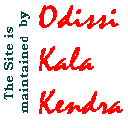|
|
|
 |
News From Odissi World |
|||
 |
Dancing with dreams |
|||
News that shook the WorldOther news on OdissiMerging into the Ultimate, via Sharon's Odissi |
Date:
21-06-1998 Pratim Ranjan Bose DRIVING past the Konark Notified Area Council checkpost towards the Sun Temple,a small hoarding on a temporary structure welcomes you to Konark Natya Mandap,the world of Guru Gangadhar Pradhan. One of the most talented exponent and teacher of Odissi dance after Guru Kelu Charan Mahaptra, Pradhan (50), is giving shape to his dream-buildinga gurukul ashram to teach the traditional dance forms of Orissa and an open-airtheatre (Natya Mandap) here on a three acre land at Konark. Pradhan's ashram is like any of those mandir-cum-ashrams found all acrossrural India. The only difference is that locals gather here not only to offer``puja'' but also to watch dance and musical programmes performed by well-traineddisciples on a dimly lit ``natya mandap'' on auspicious evenings. An organiser, teacher and performer, the dance guru is determined to turnthis place into a prominent centre. In Orissa, where, despite its culturalheritage, artists seldom get their due, Pradhan is fighting a battle to ensurea better future for them. On one of his trips to the Khajuraho festival with the late Sanjukta Panigarahi,he dreamt of holding a similar festival at Konark. Soon, in 1986, Pradhanand his wife Sulochana, organised the first Konark Dance and Music Festivalon this piece of land, on their own and if the list of performers is considered,the festival was a connoisseur's delight. Since then, it has turned out tobe an annual feature, with the Eastern Zonal Cultural Centre, Calcutta, steppingin as a co-sponsor during the last few years. Interestingly, the State Government, in all probability, borrowed the ideaand has been organising the much publicised Konark festival at a differentvenues nearer the Sun Temple since 1989. ``Though the government did notgive recognition to my efforts, I am happy that at least the horizon haswidened for the artists here nowadays,'' says Pradhan. Apart from Konark, Pradhan has put a remote town near Chilka on the country'scultural map by organising Kalinga Kala Utsav in May every year. But does his battle to preserve the rich heritage of the State end withorganising festivals? ``Not at all'', he retorts, ``artists deserve appreciationand festivals provide the right platform to mark their entry. It is moreimportant, however, to nurture young talent in the different art forms andthe biggest difficulty here is lack of social support both to the discipleand the guru''. Pradhan even personally scouts for talent, picking them up from poor familiesof rural Orissa. Never mind if it means a drain on his own savings or resentmentin the family. To save the dying form of the Gotipua dance, he has set up a training centreat Konark Natya Mandap, said to be the only one of its kind in the State.Most of the renowned Odissi gurus of the day, including Pradhan, have beentrained in Gotipua. Performed by young boys dressed as women, Gotipua was once the most popularof dance forms in Orissa. While the style is broadly similar to that of Odissithe overall presentation, which includes a little of folk ballet, is distinctlydifferent from that of the former. As Pradhan puts it: ``even 25 to 30 years ago, there were 35 to 40 differentgroups in Orissa. Today, there are only two or three'', thanks to a changein socio-economic structure and growing urbanisation of the society. On a rescue mission, therefore, Pradhan invited two of the last survivingeminent Gotipua gurus and two other accompanying hands to teach six talentedboys in the age group of five to 10, he had handpicked from the villages,at Konark. One of the most productive Gurus, Pradhan has a typical bias towards maledancers. His Orissa Dance Academy (ODA) in Bhubaneswar - the same rentedhall, he used to give lessons all through the day - takes the shape of ahostel. Pradhan sleeps on one of the beds, laid on the floor, accompaniedby a whole lot of his students from villages. The reason behind his male-bias is very simple: ``I am sure you will namea whole lot of women dancers, but how many of them have taken up the jobof teaching?'' he asks. All this, however, does not mean he does not teachgirls. Some of his talented pupils are big names today, among them beingAruna Mohanti, Madhusmita Mohanti and others. In Bhubaneswar too, where Pradhan lives five days a week, away from his familyat Konark, he trains young talented boys handpicked from remote corners,provides them a scholarship in terms of food and lodging and soon makes themself-sufficient. All this is done to create a better cultural environment in Orissa at thecost of his own career and financial insolvency. Putting all his money behindhis dream, Pradhan nowadays runs from pillar to post seeking support. |
|||
|